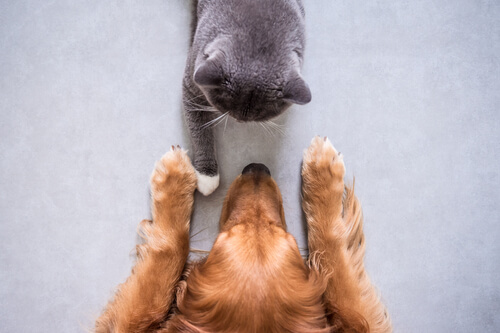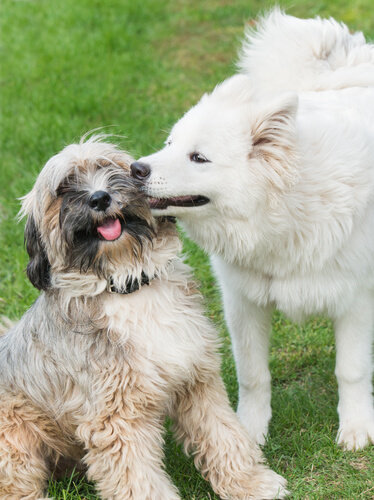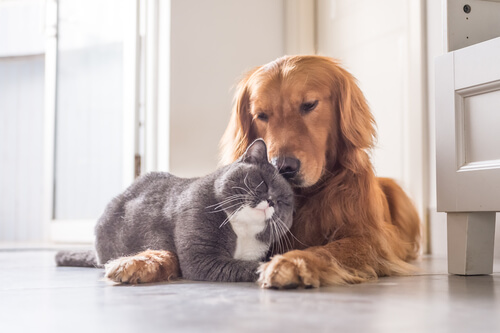Thinking About Adding To the Family?
What could be better than a pet dog or cat? Two or three of them, of course! Adding a pet to your household will take a bit more of your time, money and energy, especially at first. However, if you have these to invest, you will be amply repaid by endless love and entertainment. Best of all, your original four-legged family member will benefit as well.
Many people, who would like a second pet, hesitate for fear that Fluffy the First would get her nose out of joint. Actually, this is rarely the case. Initially, your resident pet may perceive the newcomer as competition. However, once animals get used to each other, most love the company of an animal companion and playmate. This is especially true in households where owners work long hours and pets are left alone with nothing more exciting to do than contemplate the Ficus plant.
Other pet parents fear that two or more of a kind will be less loving to their human companion than would a single pet. This is possible but, in reality, rarely happens. People with multiple animals find that there is more than enough love to go around on all sides. The bond just gets bigger and better.
Initial meetings are the tricky part. Don’t expect love at first sight. Even among humans, getting acquainted can be awkward, especially when the person doing the introduction is “match-making”. Do you remember how you felt when your mother insisted that you befriend her pick of a perfect match for you? Your first reaction was “Yuk!” even if her choice eventually turned out to be the love of your life.
Learning and applying something about animal etiquette and social behavior can help in overcoming initial barriers to domestic bliss in the multi-pet household.
If you have advance notice of when your new addition will arrive, plan to give your resident pet a refresher course in essential manners. Of course, if you fall in love with the perfect dog at the Adopt-a-thon that Aunt Tillie insisted you attend with her, or you find a bedraggled kitten in a ditch on the way home from work, you will have to go cold turkey.
Ideally, about a month before the new arrival moves in, begin to review basic animal etiquette with the resident pet(s). Cats should know and respond to their names, know that the litter box in the only place to eliminate and that the scratching place is the sole acceptable place to sharpen claws. Dogs should be clear about their names and know and respond reliably (on the first request and every time) to basic commands like sit and stay. They should also get a review of acceptable places to relieve themselves.
General Guidelines
Dogs and cats live by a pecking order. The most important issue to be settled among animals just meeting each other is who is top dog or cat. It isn’t important to the

animals who comes out on top, only that the matter be settled. You can expect some growling or hissing and even a scuffle or two. This is a normal part of adjusting as the pets sort out for themselves who outranks who. Supervise the initial encounters, but don’t worry about fights unless the fur actually starts to fly. Most animals will settle things out according to the unwritten code that governs their relationships. Once the matter is firmly settled, everyone will relax. For the first couple of
weeks or until you are sure all parties are fast friends, keep new and resident animals separated in different parts of the house when you aren’t there to supervise.
If the original pet and the newcomer are closely matched in age, size and sex settling rank will take longer. Pets of different age and sex will become friends most easily. For instance, a female dog will adjust faster to a male dog than to another female. Introducing a young male dog to an older female dog will be even easier. The same is true of cats.
Leave Time for Introductions. If possible, bring the new pet home when you have 2-3 days to spend helping everybody adjust. A long weekend is ideal. Your constant presence will reassure the original pets. The newcomer will have an extended time to get to know you. Spend some of your time training. Teach the new dog its name and begin one or two of the five basic commands (sit, stay, down, come, heel). Sit is a good place to start with your new addition. Don’t forget to include your original dog in the training session. Have him run through his routines so that he won’t feel left out. Your new pooch may pick up some tips and motivation by watching your resident expert “strut his stuff”. Teach a new cat its name and encourage it to use its own litter box (this should not be the same one used by the resident cat).
Spend more Time with No. 1. By spending more time with your resident animal you will accomplish two things:
- You will reassure your original pet that it has not been displaced and is still a valued part of the household
- The new animal will start seeking attention from the resident pet because it is not getting all of its needs met by you.
Be Cool. Animals are very sensitive to the mood of their human companions. If you are nervous, they will pick up on it and mirror your emotions. Act as if having a new addition to the household is the most natural thing in the world. A relaxed attitude on your part will smooth the road to everyone “living happily ever after”.
Be Patient. Depending on the individuals involved (and they are all individuals, no matter how long your neighbor says the process took with her pets), the get- acquainted period may be a day, a week or six weeks. Give everyone the time and space they need. Eventually they will settle down to a peaceful co-existence.
Spay and Neuter. Altered animals are far more likely to get along peacefully together. Spay or neuter your pets as soon as they are old enough.
Getting Down to Specifics
Fido, Meet Rover
(Resident Dog Meets New Dog)
It is natural and healthy for a dog to be protective of its territory. By guarding its territory in the wild, the dog is establishing a stable, safe hunting and breeding area. It also provides a protected area for raising young. Our pet dogs, rightly, view the house that they live in as their territory. This is what prompts the domestic dog to bark an alert when a stranger approaches its house or yard. Most canines view the arrival of another dog in the house as an invasion of their turf, so don’t just walk in the front door with the new dog who will be perceived as “the intruder”.
Instead, plan to make the initial introduction on neutral ground — a park, school yard or playground. Arrange to have a friend bring the new dog to the assigned meeting place. You bring your resident dog separately, just as though you were going out on your usual walk or jaunt. All of you can meet casually at the prearranged spot and both Fido and Rover can break the ice with a get-1they can relax and become friends without having to get uptight about who is usurping whose space. When both dogs are comfortable with each other, all four of you can walk home together. Now you will be bringing your dog’s new friend into the house rather than a stranger.

Even though Rover and Fido have met and played in the park, there will still be some jockeying for position inside the house for a period of time. If either dog is reluctant to show ready acceptance of the other, keep each dog in a separate room when you are not home to supervise. When you are at home, have short fun periods with the dogs together. Play ball, go for walks and pass out treats as if they were going out of style. In short, you want each dog to associate being with the other with having a good time. This period could last anywhere from a day to several weeks.
If the dogs are still having difficulty getting along, despite your best efforts, try “affection training”. For example: have the resident dog (on a leash) sitting beside you while a friend brings the new dog (also on a leash) into the room. Whenever the resident dog behaves politely, praise him lavishly (Good dog, Fido) in a soft and loving voice. If Fido exhibits any sign of displeasure (i.e., growling or snarling) at the arrival of the new dog, show your displeasure immediately by harshly shouting, “Fido, No!”
Remember to always use the resident dog’s name when either praising or disciplining. If you don’t, Fido may think that you are talking to the new dog
Tabby, say Hi to Rover
(Resident Cat Meets New Dog)
Despite the myth that dogs and cats are natural enemies, most “mixed marriages” work out just fine. Nothing is more wonderful than a puppy/kitten combination. It’s a double dose of youthful high jinks. Youngsters are relatively inexperienced, flexible and will probably become fast friends and companions quickly. An older new or resident dog will very likely get along famously with a kitten. However, even the most friendly dog that is inexperienced with cats may not realize the fragility of a small kitten. Since a playful nip could injure a tiny kitty, you should supervise all interactions until Rover becomes more savvy about appropriate play with kittens.

Individual adult canine/feline relationships depend a great deal on the personalities of the two animals and on the attitude of their human companions. Remember, your pets will pick up on your emotions and expectations, so stay cool, expect good behavior and reward it when it happens.
In order to ensure a safe start, trim a mature cat’s nails. At some point the dog is sure to get too close, too fast for Tabby’s comfort and she will reach out to swat Rover’s nose. Rover’s feelings will be hurt more than his nose but he will have learned an important lesson about Tabby’s limits. Once they have reached an understanding of Tabby’s boundaries, they will settle down to being good friends. Rover may have to make more than one of these mistakes before getting the picture.
Keep Rover in one room as much as possible for the first few days. This will accomplish several things. First it will make house training easier. Next it will give Tabby some time and safe space to acclimate to Rover’s presence. Both dog and cat can sniff safely through the barrier separating them and gradually get used to the sight and sound of each other.
If you have any doubts about how a cat and dog will get along, don’t leave them together unsupervised for the first couple of weeks. Since Rover’s arrival is an invasion of Tabby’s territory, you should reassure Tabby often. Plenty of extra stroking and playtime sessions will help to bolster a doubtful feline. And don’t forget the kitty treats for cats that like them.
Fido, This is Purry
(Resident Dog Meets New Cat)
Here again the combination of young and adult animals will work out most easily. Follow the steps outlined above for bringing a new cat into your home. Do your best to prevent jealousy on the part of your dog by giving him more time, reassurance and attention. The new cat will not suffer from this as felines are more independent than canines. Your dog is closely attuned to the social structure of your household and will be more sensitive to feelings of displacement.
To test how ready Fido is to be introduced to Purry, set the closed cat carrier down on the floor with Purry in it. Let Fido sniff the carrier, encouraging polite behavior. Many dogs will be merely curious on first examination of the carrier. If this is the case you are ready for the next step. However if Fido becomes overexcited, take the crate away and try the same steps again later, until he is only mildly curious.
The next step in the “Lets be friends” process is to hold the cat (assuming that Purry is not excitable or afraid) in your lap. Ask another person to bring Fido (on a leash) close enough to sniff. Reward each pet with lots of praise and petting for good, peaceful behavior. Scold the dog immediately for any impolite behavior such as growling. In a strong stern voice say something like, “No, Fido!!!”
If Fido wants to lunge at Purry, scold him strongly and remove him from the room and isolate him for 15 minutes or more. Try this exercise later after both pets have settled down. Learning to act politely around cats is for the protection of Fido as much as for the safety of Purry. (A canine that doesn’t know the power of an enraged cat is in for a rude surprise.). Whenever Fido and Purry meet quietly, let them know just how pleased their good behavior makes you.
SUMMARY
Whatever combinations of animals you introduce, remember to give your pets plenty of time to work things out for themselves. Their relationships may not be precisely what you had envisioned, but 98% of the time they will work out an arrangement that is satisfactory to both them and you. On the whole, domestic animals are very adaptable and resilient. A smooth and careful introduction will go a long way toward the making of life-long friends.

